Justice groups are calling for the Metropolitan Police to scrap its “shady” gang intelligence database as a major report is set to reveal that more than a third of the people on it have not committed any serious crimes.
While the London Mayor’s Office has begun a promised investigation into the ‘Gangs Matrix’ to be released this year, two reports, by Amnesty International and police monitoring group, StopWatch, are set to lay bare a host of claims that it is “infringing on peoples’ civil liberties”.
HuffPost UK understands that Amnesty has uncovered that 35% of the 3,600-odd people on the database have not committed “serious crimes”, 75% have been victims of crime themselves and 80% are aged 12 to 24.
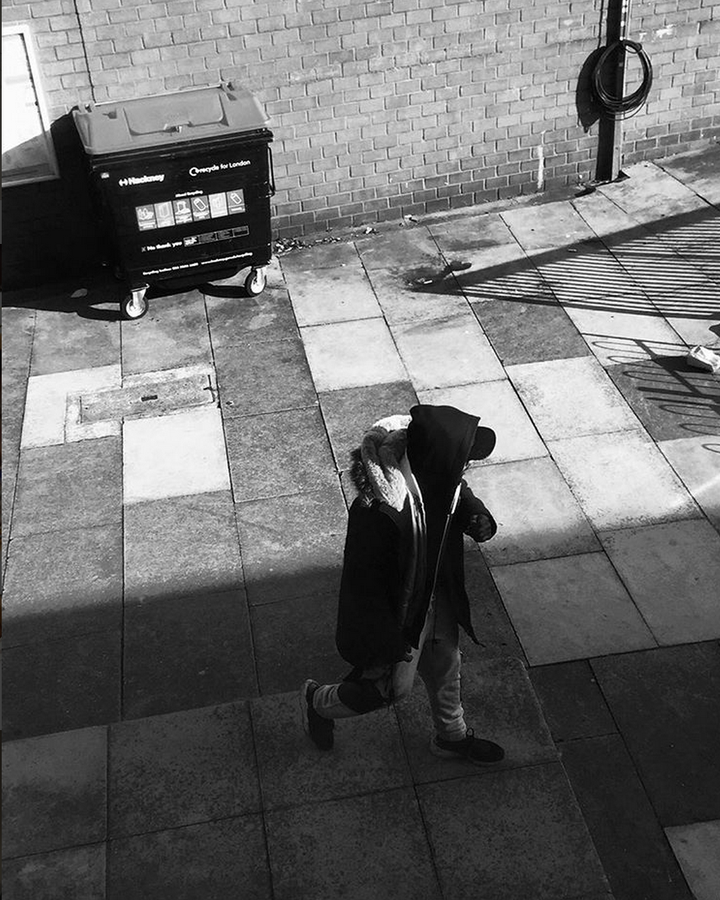
The matrix, once described as an example of “institutional racism in action”, has been a point of contention for several years due to the disproportionate amount of black, Asian and minority ethnic (BAME) people to feature on it. Some 87% of people in 2016 were BAME, of which black men accounted for 78%.
Amnesty confirmed it is “looking at the nature of the profiling and the consequences thereafter (of being on the matrix),” but declined to comment on its finding, which a spokesperson said, were “delayed for now”.
A MATRIX OF ‘MEDDLING’
Other concerns raised to HuffPost by criminal justice groups are that the matrix is being used to influence its subjects’ education, employment and housing opportunities and in “extreme cases”, to remove children from family homes.
Police have also used it to try and influence other agencies, like the DVLA, to say “this individual is not worthy to drive”, criminologist Patrick Williams, who is leading the StopWatch report, claims.
Williams - who in January last year published a report along with his university colleague, Becky Clarke called Dangerous associations: Joint enterprise, gangs and racism - is interviewing young people who have been, or are thought to have been on the matrix, and highlighted how little, even its subjects know about it.
As an example, he cited the case of one London youth who a community worker helped get off the matrix, only to find out a year later he was still on it.
Veteran racism campaigner Stafford Scott, the corner-man for the families fighting the Metropolitan Police over some of the UK’s most controversial cases, is blunt in his assessment of the impacts the matrix has on young men. When someone is added to it, “that kid is fucked, and when I say, ‘fucked’, I mean ... ‘they are fucked’.”
The Met declined to comment on the level of criminality of those on the database or respond to other criticisms levelled at it, but in a statement said the database - formed after the 2011 London riots - provides it with “an up-to-date picture of the different gangs operating in London, something that had never previously been available”.
The statement continued:
“The matrix measures gang membership and violence. There needs to be multiple intelligence indicating gang membership and the violence criteria is either based on intelligence or violence convictions.
“It can be used to identify those individuals who are more likely to commit offences, as well as those at risk of being affected as victims; providing the police and partners with an opportunity to offer support and take steps to prevent further offending or victimisation through an appropriate intervention, such as a diversion programme.”
A DATABASE BORNE OF ‘FALSE BELIEFS’
For Scott, the Matrix is rotten to its core, having been borne out of a “false” narrative propagated by authorities after the riots - that gangs were to blame.
That same contested plot-line was present in the police shooting of Mark Duggan on 4 August 2011, an event that in part, sparked the riots which raged for four days, causing £200 million of property damage and leaving five dead.
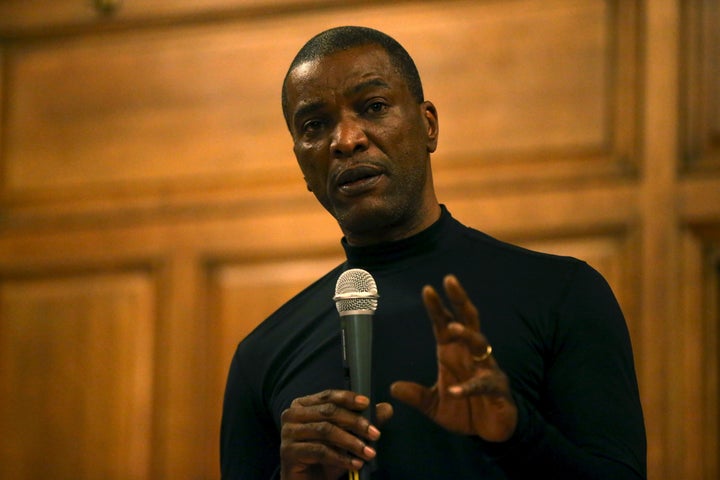
In the aftermath of the riots, then Prime Minister David Cameron promised a “concerted, all out war on gangs and gang culture” and launched a task force, led by his successor, then Home Secretary, Theresa May.
However, just two months later Home Office and Ministry of Justice analysis concluded gangs did not play a pivotal role, making up just 13% of those arrested.
“They wanted to deny any social or economical reason or rational for those young peoples’ behaviour,” Scott recalls, before explaining how instead of the Gangs Matrix being shelved off the back of those findings, it was fast tracked, in part, he claims, by the Home Office “redefining” the number of people required to constitute a gang - three - which allowed authorities to “inflate the (gangs) risk”.

“That’s absolutely stupid... I mean come on man, three people make a gang,” Scott says of that decision.
“A gang is an organised structure where everybody has a role and a rank and everybody is working for the same ends. Three people? They did that so they could re-define the number of gangs there are across London.”
A further concern to Scott is who police classify as gang members. He claims the “bias” goes beyond ethnicity - police are picking “easy targets”.
Despite Green Lanes, the 6.3 mile strip between Newington Green and Wichmore Hill, in Harringay, being as well known for its Turkish and Kurdish residents, as its heroin supply, Scott says the gangs database for the area - which he has seen - records no Turkish gangs and lists only one Turkish boy out of 100 listed gangsters - the other 99 are black. The Tottenham Boys, the main gang in the area is absent from the list. In Scott’s home borough of Hackney, the Hackney Bombacliar are a notable exception from the data.
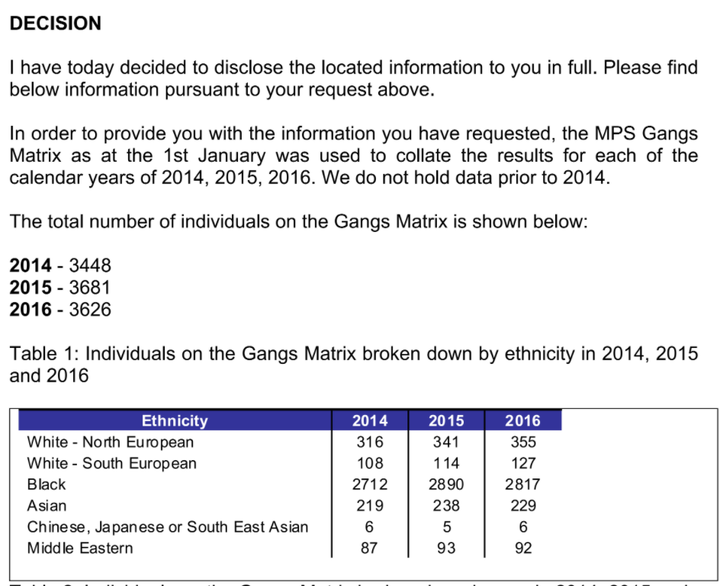
“When we put in a Freedom Of Information request to Scotland Yard asking about the make-up of the gangsters (on the matrix), the answer that we were given was that there were 3,800 gangsters in London, of which over 3,000 are black (the FOI shows 2817). When asked specifically.... if you see the letter, you’ll see, ‘north European, south European, Asian, Chinese’ and then they say ‘black’. Well black is a colour. Everyone else is defined by their geography and ethnicity, then it’s just black. When asked about Chinese gangsters the Met said there’s six of them in London. But there’s over 3,000 black gangsters in London.”
A MATTER OF NATIONAL CONCERN
A review by MP David Lammy in September found BAME subjects on the gangs database faced longer sentences and being treated more harshly throughout the criminal justice system, something the Mayor of London’s office is investigating further, fulfilling a pledge Sadiq Khan made in his manifesto.
“The Lammy Review supported this commitment and asked us to examine the way information is gathered, verified, stored and shared, and to consider community perspectives, including any suggestion of disproportionality,” a spokesperson for the Mayor told HuffPost.
“Work on the review has started, and the findings will be discussed with the Met, with our recommendations published next year.”
The Centre for Crime and Justice Studies (CCJS) is among the groups critical of the matrix and earlier this month (December, 2017) met with health specialists to discuss the psychological impacts experienced by those on it, “quite a lot of” whom, it said, are “being surveilled having not broken the law in any serious way”, if at all.
The centre is calling for the database to be “abandoned” because it “carries with it too many infringements of civil liberties and too unjust long sentences”.
Those concerns are echoed by civil liberties and human rights group, Liberty, which describes the database as “shady” and claims the Met’s use of it is “dividing communities, damaging police-community relations and undermining people’s rights”.
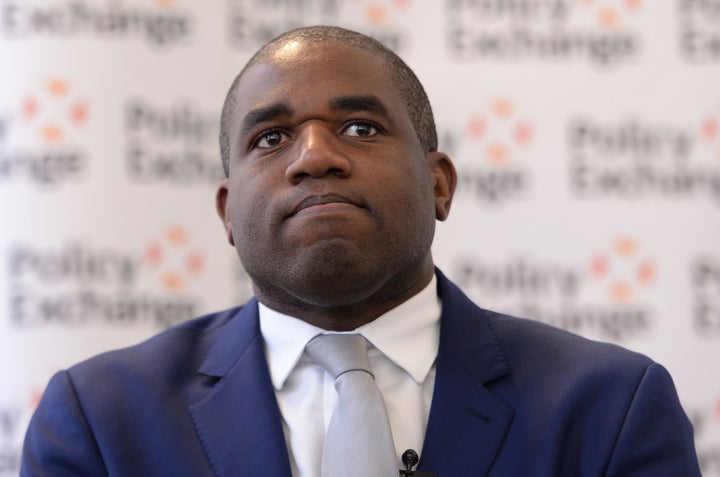
Williams said while his StopWatch work is in its infancy, he believes the gangs intelligence system is a “spurious tool” which is “potentially” being used to infringe on peoples’ rights.
“There are individuals on the matrix that are unaware they are on the matrix so it becomes this really spurious tool, a really strange tool,” the Manchester Metropolitan University senior lecturer said, adding that once people get on the database “it is extremely difficult to get off” due to a “once a gang member, always a gang member” police mentality.
“Amnesty is really interested in this (the matrix), as is Liberty because they believe potentially what they (the Met) are doing is infringing peoples rights... and this may well contribute to a series of data harms,” he added.
As an example of the impacts of life in the police’s crosshairs, Scott recalls a shooting in north London’s, Wood Green, on 10 July 2015, that resulted in the death of Erdogan Guzel, a 42-year-old father-of-two, and the serious wounding of Sonya Gencheva, 51, when a gang sprayed a bakery with machine-gun fire. The pair were not the intended targets.
Scott’s story focuses on the man, who he did not name. The Met declined to comment on Scott’s version of events.
The police eventually find the target, and they say to him, ‘right, who was shooting after you?’.
And he says, ‘you know, I haven’t got a clue. I was out with my mum and my sister. I saw a car and because it had blackened out windows and it slowed down a little way ahead of me, I took notice. At the point that I saw the window wind down and the barrel of a machine gun out the window, I legged it... then I heard the bullets. I didn’t even look behind me because someone was trying to kill me’.
They (police) say to him, ‘you’re in a gang’, because one of their beliefs is that if a gang attacks you, you must also be in a gang. This is almost like a policy.
So they say to him, ‘you’re a member of the Wood Green Mob’. He says, ‘listen, I was born in Wood Green, I know everybody. But I went to prison and I come out. I don’t get involved in anything. But, yeah, I know everybody. I hang out with everybody, I don’t care what they do. It’s nothing to do with me’.
They (police) say, ‘for us to give you protection, you have to accept you’re a gang member’.
And he says to me, ‘you know what Staff... someone just tried to kill me, these guys won’t give me protection unless I play the game. So I start to play the game. I comply. I go to the places they tell me I need to go to’. Because they need to put them through some process.
So he says it comes to a point where they (police) again ask him again who shot him. And he says, ‘look I don’t know. The streets know. There’s names out on the street’. But they’re asking him to give them witness statement, quality evidence. And he says, ‘I don’t know’. And they (police) say, ‘you know what, fuck you... we’re cutting you loose’. And they cut him loose and he’s a guy that people want to seriously kill. They cut him loose. He says he goes to housing, says ‘I need a new house. I want to be re-housed please’. They (housing officials) say, ‘no, you’re a gang member. Your not complying. We will give you no service’.
A couple of weeks later, he gets chased. He’s driving a Smart car. The car behind him is much more powerful. He tries to get away. He crashes the car. Turns it over. He gets stabbed four times. A couple in the lungs. They were trying to kill him. He goes to hospital. The police turn up. They (police) say, ‘who did it?’. He says, ‘I don’t know, I crashed my car, my glasses came off in the car... they had on bandanas. I don’t know’.
Police say, ‘you’re not complying. We’re not going to give you no protection’, then they walk away and leave him.
Rachel Robinson, Advocacy Manager for Liberty, is pointed in her criticisms of the gangs matrix: “Far from reducing violent crime, this shady database is dividing communities, damaging police-community relations and undermining people’s rights.
“It disproportionately affects young black men and feeds a popular narrative of gang violence that is inaccurate and discriminatory,” she said.
Evidence presented to the London Assembly in July last year revealed that “gang activity is present in only a small proportion of serious youth violence”.

Williams: “Serious violence is not driven by the gang, these are driven by other factors, but the gang is used as a way of signifying, ‘well this is the cause’. The gang is often used as the driver of violence across London. But that is not borne out empirically, or by statistics.”
Liberty’s Robinson called for more transparency around the use of the matrix, saying that inclusion on the list can be “devastating” for young people.
“We don’t know how or why people end up on it, how or why they’re removed and what data sources the force uses to populate it. People have no way of challenging their inclusion – but being labelled a ‘gang member’ can have a devastating impact on their lives"”
She also called for the Met to “urgently” produce guidance setting out “clear, targeted criteria for including people on the matrix and robust safeguards against its disproportionate and discriminatory use”.
Will McMahon, deputy director of the CCJS, shared Robinson’s concerns with where police were “drawing” information from to populate the matrix and how they were then using it to set “people up to be prosecuted”.
“What it (the matrix) is doing, it is creating a pipeline for the BAME community into the criminal justice system on the basis that you’re on the database, so you must be trouble. And this is very concerning.”
McMahon likened the database to the now defunct “sus laws” which permitted police in the 1970s to stop, search and potentially arrest people on suspicion of them being in breach of section 4 of the Vagrancy Act 1824
“People are being surveilled having not broken the law in any serious way, perhaps not even at all,” he said, adding that the matrix’ focus on BAME individuals meant “there’s a whole community that is being treated as a suspect community”.
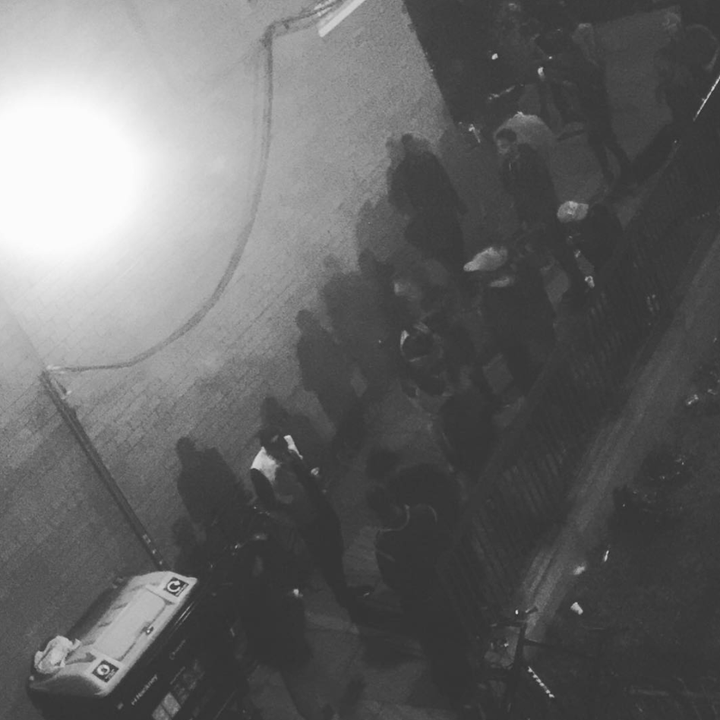
FROM THE MATRIX TO THE DOCK
The effects of the matrix are most dramatically demonstrated in the court system where the “gang” connection is often used through Joint Enterprise - a law which allows the accomplice, or co-offenders to be treated the same as the person who committed the violent act - to secure multiple convictions.
Williams, in a speech last month to a group campaigning for Joint Enterprise laws to be reviewed, cited a recent case in Moss Side, Manchester, as an example. Ten young men, and a youth aged 14, were jailed for a combined 170 years over the murder of Abdul Wahab Hafidah in May 2016.
He told the Joint Enterprise Not Builty by Association (Jengba) event, held at the House of Commons, that many of the young men jailed over the death “were punished for their non-criminal associations - their childhood friendships, their family relations and connections”.
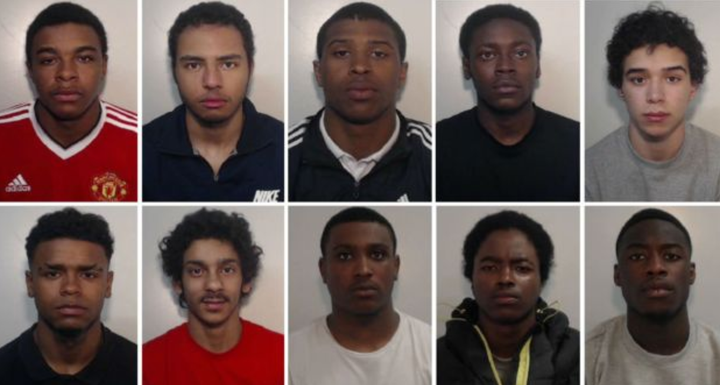
Williams: “They were punished for their non-criminal involvement, such as appearing in music videos, wearing similar clothes, for attending the same schools, colleges, for living on the same street. The travesty of Joint Enterprise in that non-criminal behaviours can become misused by the police and prosecution team - used to connote common purpose and subsequent intent.”
In February 2016, the Supreme Court ruled Joint Enterprise had been “misinterpreted” for three decades, having taken a “wrong turn” in the 1980s, and quashed the murder conviction of Ameen Jogee. Despite what campaigners had hoped for, the landmark decision did not “open the flood gates” for others convicted under the law. Jengba currently support over 800 prisoners, the youngest of which is 13. Almost 80% are from BAME communities.
In December, in response to the Lammy Review - which also found that people from BAME backgrounds make up 25% of the prison population and 41% of the youth justice system, but only 14% of the general population - the government pledged to collect wider datasets related to ethnicity for more accurate analysis and review use of ‘gang’ prosecutions for those who are victims and exploited by adults.
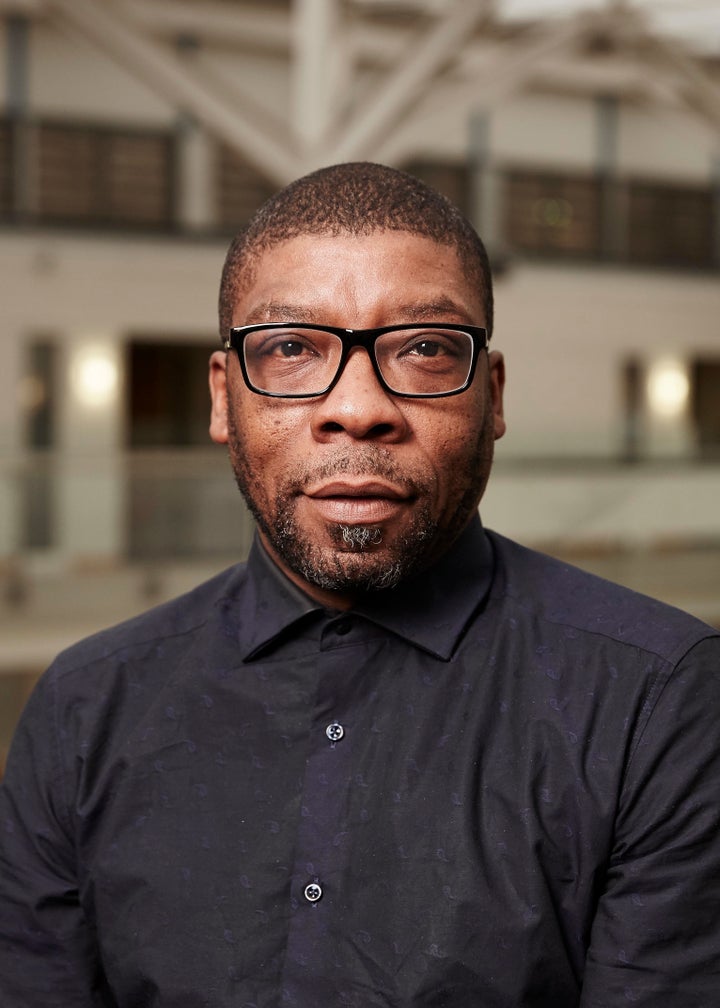
Williams said his “concern” in times of austerity and cutbacks in police funding was that “we talk up the risks posed by certain individuals because that becomes the best way you can attract funding and resources”.
Scott added: “This (targeting of BAME youth) is happening at a time when our young people are getting battered with the impact of austerity. Our young people have no where to go. They have nothing in their pockets. They’ve got nothing to do. They’re forced out on the streets.”
MULTI-AGENCY FAILINGS
Scott says problems began with gang profiling when police community consultancy groups were scrapped by former Prime Minister Tony Blair in favour of safer neighbourhood partnerships which put the police “in the same room” as councils.
“So now the local authority is no longer the arbiter, the local authority becomes the pockets of the police. The police control those meetings because they’re about community safety, or safer neighbourhoods,” he explained.
“The police say to the council workers, ‘look at those kids on the estate’. The behaviours that in my day would have been described as been anti-social behaviour, is now described as gang-associated behaviour.
“So kids are being identified as gang members because of who they hang out with on the estates that they were born on to.””
Scott uses himself as an example of how police suspicion can have dire consequences for the person wrongly identified as being a gang member.
“The police man says to these (safer neighbourhoods) people, ‘Stafford is a gang member, he hangs out with other known gang members. I can’t give you any evidence of it, but take my word for it’.
“And of course they do because the police have told them what to look out for. ‘If you see Stafford standing on the corner smoking a spliff with another known gang member he must be in a gang’.
“So everyone now believes I am in a gang.
“I get no services, everywhere that I go. They keep telling me ‘I’m in a gang and that If I don’t get on these programmes to exit the gang they’re going to make my life difficult’ because the police has told them, ‘we can’t get no evidence on these guys... so we’ve got to do disruption tactics’.
“The minute they talk about disruption tactics, what they’re doing is unlawful. Because if those kids were doing anything unlawful they should arrest them. The evidence would be there.
“These kids aren’t particularly bright. The majority of them have been kicked out of school or have left school. This is an absolute joke. So all of these agencies... to get on the ‘Matrix’ only two of these agencies need to decide your a gang member. But they’re all in the same space anyway and they take what the police say for granted.”
Scott claims the “most significant agency”, apart from police, identifying gang members is the employment services, which riles him further.
“You can do as much research as you want to do but you will not find any module in the training programme for an employment service officer that gives them the skills to be able to identify a gang member.”
“The whole terrain is crazy,” Scott says of the world young men identified as being gang members find themselves in.
“And they (police) get away with it because every other agency, every other agency is part of these Safe Neighbourhood Boards and they all listen to the police, and they all do the polices’ bidding, and all of this happens without there been any evidence, because where there is evidence people get arrested and sent to prison.
“People have got to start taking notice of what is going on.”
When speaking to HuffPost, Williams was keen to reiterate that he wasn’t a “gang denier” and understood the need for police intelligence gathering, but argued that, “in an ideal world” a youth’s involvement in crime should lead to them been supported “towards a non-criminal lifestyle” rather than persecuted.
“So supporting college applications, supporting employment opportunities, ensuring these individuals have a stable environment in which to live. I’d almost argue that the (gang) label counters all of that. What we refer to as protection factors - family, education, schooling, stable employment etc, the gang label almost becomes a barrier over which these young people continue to fall. It becomes a barrier for them to participate as a citizen.”
